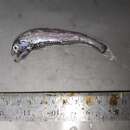en
names in breadcrumbs


View data on catalog of fishes here.
Dorsal-fin rays 12–13 (14), typically 12. Anal-fin rays 30–34, typically 31–32. Pectoral-fin rays 9–10, typically 10. Vertebrae 44–45, including 19 anal vertebrae. Gill rakers 5 + 11, very rarely 6 + 10 or 5 + 12. Pyloric caeca 7–8. Peritoneum black; anal opening bordered by black ring. SL 4.0–4.6 times greater than head length, decreases with growth. Eye diameter greater than width of interorbital distance or equal. Head length 1.3–1.4 times upper jaw length. SL 5.3–7.3 times body depth, decreases with growth. Photophores: OV and VAV on same level, anterior 1–2 VAL sometimes slightly raised; VAV and VAL 8 each; 2 anterior AC photophores, 1 of them usually slightly raised; AC 24–25, including 17–19 above the anal fin.
Parin N, Borodulina O. 1990. Survey of the genus Polymetme (Photichthyidae) with a description of two new species. Voprosy Ikhtiologii 30(5):733–743.
The following morphologic description of the genus is based on Parin and Borodulina (1990). Body elongate, vertebrae 42-46. Eye normal. Mouth large, two rows of premaxillary teeth. Branchiostegal rays 13–14. Gill rakers 15–19, typically 16 to 18. Dorsal-fin rays 10–13 (14), Anal-fin rays (25) 27–34. Pectoral-fin rays 9-11. Pelvic-fin rays 7. Pelvic fins far anterior to the dorsal-fin origin. Origin of anal fin below the end of the base of the dorsal fin. Adipose fin present. Photophores: ORB 1, by the anterior margin of the orbit. OP 3. SO 1. BR 9–10. IV 21, 10th slightly raised; VAV 8–9; AC 22–25, of them, 15-19 above the anal fin, anterior 2 may be slightly raised; IC 50–54. OV 9; VAL 8–9, anterior 1 or 2 may be slightly raised; OA 17-18.
Greatest length to 216 mm.
Northeastern Atlantic, 25°47'N, 15°45'W, depth 500 meters.
Holotype: ZMMU P-13768A.
Polymetme thaeocoryla is a species of fish in the family Phosichthyidae (lightfish).[2][3]
Its specific name is an anagram of the similar species, Polymetme corythaeola.[4] It has no common name in English, but in Spanish is called luciérnaga musculosa ("muscular lightfish") and in French luisant grand feu ("gleaming [fish of] great fire").[5][6]
Polymetme thaeocoryla has a dark dorsum, with silver flanks and a black pigment on the outer caudal rays. Its length is maximum 21.6 cm (8.5 in). It has 12 or 13 dorsal soft rays, 30–34 anal soft rays, 44 or 45 vertebrae, 7 or 8 pyloric caeca and 17–19 photophores above the anal fin.[4]
Polymetme thaeocoryla is benthopelagic, living in the Atlantic Ocean at depths of 213–1,400 m (699–4,593 ft).[7][8][9]
Nothing is known of its early life stages.[10]
Polymetme thaeocoryla is a species of fish in the family Phosichthyidae (lightfish).
Its specific name is an anagram of the similar species, Polymetme corythaeola. It has no common name in English, but in Spanish is called luciérnaga musculosa ("muscular lightfish") and in French luisant grand feu ("gleaming [fish of] great fire").